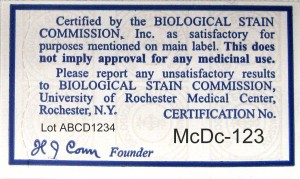One of the main objectives of the Biological Stain Commission is to ensure the quality of dyes through independent testing to meet appropriate chemical and performance criteria.This objective is met by:
- Analysis in the Commission’s laboratory of dye content and composition of samples submitted by dye manufacturers or vendors.
- Testing performance of dye samples in standardized procedures known to be discerning tests of the staining quality of the dye.
- Issuing certification labels to be attached to the containers used by companies marketing accepted dyes to assure consumers that these dyes have met the performance criteria of the Biological Stain Commission. Most consumers are vendors of ready-made dye solutions; many others are laboratory scientists who prepare their own staining solutions.
- Conducting and supporting research on biological stains and histochemical techniques.
For a detailed account of the tests currently in use by the BSC, see Penney DP, Powers JM, Frank M, Churukian C (2002) Analysis and testing of biological stains – the Biological Stain Commission procedures. Biotechnic & Histochemistry 77: 237-275. The tests are summarized in Conn’s Biological Stains (4th ed., 2002), Chapter 28, pp. 417-425, by the same authors. Revisions to the testing methods and criteria are published from time to time in the commission’s journal Biotechnic & Histochemistry, as are tests for new additions to the list of certified stains. Several revisions and a few new dyes have been added since 2002. The BSC certifies dye powders, not staining solutions. Certified stains are powders. They include dyes (most items) and a few other compounds (fluorescein isothiocyanate, protargol S, resazurin) that are used to improve visibility, mainly in the fields of human pathology, hematology and bacteriology, but also in microbial, animal and plant histology. Many dye powders contain more than one colored component, and almost all contain colorless substances such as sodium chloride, dextrin etc. These impurities can affect performance. For example, a certified basic fuchsine that is OK for staining acid-fast bacteria and making Schiff’s reagent might not work in the aldehyde-fuchsine method for staining insulin in the beta-cells of pancreatic islets. Beta-cell staining requires pararosaniline, one of the 4 components of basic fuchsine. (Pararosaniline is also sold as a single dye; it can be used in all applications requiring basic fuchsine.) Another example is alcian blue 8G, which becomes unstable if the dye powder does not contain enough boric acid. There are more stable variants of alcian blue, some of which are stable even with dye content above 80%. Some alcian blue variants can be used for all the original applications of alcian blue 8G. Others are good for techniques commonly used in histopathology but not for more critical work in carbohydrate histochemistry. A BSC certificate identifies applications for which the tested batch of a product is OK.
Most major vendors of biological stains sell Biological Stain Commission certified dyes – look for BIOLOGICAL STAIN COMMISSION CERTIFIED or CERTIFIED entries in their catalogues.
[su_note note_color=”#e1ffff”]
BE SURE THAT YOUR BOTTLES OF DYE POWDERS SHOW THIS LABEL:
 A newly designed label, shown to the left, is affixed to bottles of dyes certified from January 2010 forward. The new label includes the original manufacturer or vendor’s lot number (above the late HJ Conn’s signature) as well as the BSC’s Certification number (in the bottom right corner). There are also security features built in to the newer design.
A newly designed label, shown to the left, is affixed to bottles of dyes certified from January 2010 forward. The new label includes the original manufacturer or vendor’s lot number (above the late HJ Conn’s signature) as well as the BSC’s Certification number (in the bottom right corner). There are also security features built in to the newer design.  Dye powders with older labels will be encountered on bottles of stains certified in years before 2010. An example of an earlier Certification label is shown here. The old labels did not include lot numbers, but these can be verified directly with the BSC. Older Certification label, discontinued after 2009 [/su_note]
Dye powders with older labels will be encountered on bottles of stains certified in years before 2010. An example of an earlier Certification label is shown here. The old labels did not include lot numbers, but these can be verified directly with the BSC. Older Certification label, discontinued after 2009 [/su_note]
Why Choose Certified Dyes?
The Commission tests commercial dye batches in its independent laboratory – only those passing our assay limits and working satisfactorily in specified staining procedures are Certified. Remember the wording “Certified by the Biological Stain Commission” Take note that some vendors sell dyes with similar descriptions, such as “Certified” (by whom?) or however, these have not been assessed independently in this way and are not Certified products. The BSC Certification is cost- effective. Shop around: BSC Certified stains are often less expensive than non-certified. The assay criteria, and routine staining methods, used by the Commission’s laboratory are in the public domain; see Conn’s Biological Stains. Updates to testing procedures or standards are published from time to time in the Commission’s journal, Biotechnic & Histochemistry, which has six issues per year. Each issue includes a list of recently certified stains, with their vendors and certification numbers.
